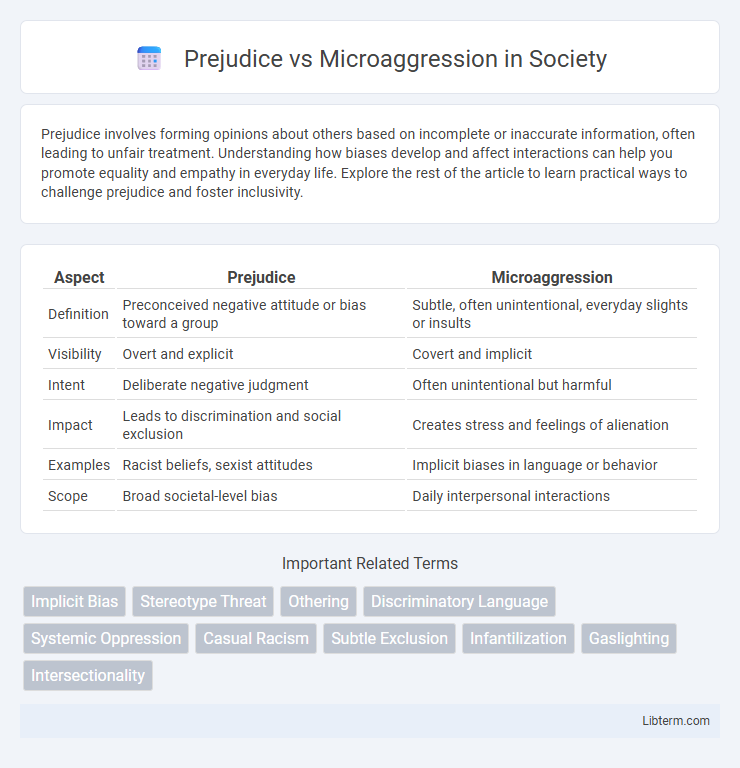Prejudice involves forming opinions about others based on incomplete or inaccurate information, often leading to unfair treatment. Understanding how biases develop and affect interactions can help you promote equality and empathy in everyday life. Explore the rest of the article to learn practical ways to challenge prejudice and foster inclusivity.
Table of Comparison
| Aspect | Prejudice | Microaggression |
|---|---|---|
| Definition | Preconceived negative attitude or bias toward a group | Subtle, often unintentional, everyday slights or insults |
| Visibility | Overt and explicit | Covert and implicit |
| Intent | Deliberate negative judgment | Often unintentional but harmful |
| Impact | Leads to discrimination and social exclusion | Creates stress and feelings of alienation |
| Examples | Racist beliefs, sexist attitudes | Implicit biases in language or behavior |
| Scope | Broad societal-level bias | Daily interpersonal interactions |
Understanding Prejudice: Definition and Origins
Prejudice refers to preconceived opinions or attitudes toward a group or individual based on characteristics such as race, ethnicity, gender, or religion, often rooted in stereotypes and societal conditioning. Its origins trace back to socialization processes, historical power dynamics, and cultural narratives that reinforce in-group favoritism and out-group bias. Understanding these foundational elements is crucial for addressing discriminatory behaviors and promoting social equity.
What Are Microaggressions?
Microaggressions are subtle, often unintentional, verbal or behavioral slights that convey negative or discriminatory messages toward marginalized groups. Unlike overt prejudice, microaggressions can be brief and commonplace, yet they cumulatively contribute to social alienation and psychological stress. Examples include dismissive comments about someone's cultural background or assumptions based on gender, which reinforce systemic inequalities.
Key Differences between Prejudice and Microaggressions
Prejudice refers to preconceived, often negative attitudes or beliefs about a group based on characteristics such as race, gender, or ethnicity, which can lead to discrimination. Microaggressions are subtle, often unintentional verbal or behavioral slights that convey derogatory or hostile messages to marginalized groups. The key differences lie in the scale and intent: prejudice is a broad, overt bias, while microaggressions are everyday, covert interactions that cumulatively impact individuals' well-being.
Historical Perspectives on Prejudice
Historical perspectives on prejudice reveal deeply entrenched social biases that have shaped systemic discrimination across centuries, including racial segregation, gender inequality, and class-based oppression. Prejudice has been institutionalized through laws, cultural norms, and social practices, serving as a foundation for unequal treatment and social hierarchy. Unlike overt prejudice, microaggressions are subtle, often unconscious expressions of bias that perpetuate marginalization by reinforcing negative stereotypes on a day-to-day basis.
Everyday Examples of Microaggressions
Microaggressions are subtle, everyday verbal or non-verbal slights that convey negative or derogatory messages to marginalized groups, often unconsciously. Common examples include asking a person of color "Where are you really from?" or complimenting someone's English skills based on their ethnicity, both implying they are perpetual outsiders. These microaggressions accumulate over time, contributing significantly to the emotional toll and perpetuation of systemic prejudice.
Psychological Impact of Prejudice
Prejudice generates significant psychological distress, often leading to chronic stress, lowered self-esteem, and increased risk of depression or anxiety disorders. The internalization of negative stereotypes can result in long-term emotional trauma and diminished social functioning. Continuous exposure to prejudice undermines mental health resilience and hampers overall well-being.
Hidden Harm: The Consequences of Microaggressions
Microaggressions inflict hidden harm by subtly undermining the well-being and self-esteem of marginalized individuals through everyday verbal, nonverbal, and environmental slights. Unlike overt prejudice, microaggressions operate covertly, making their psychological impact cumulative and difficult to address, leading to chronic stress, anxiety, and feelings of exclusion. Research highlights long-term consequences such as decreased job satisfaction, academic performance, and mental health disparities among affected groups.
Addressing Prejudice in Society
Prejudice manifests as biased attitudes and unfair judgments toward individuals or groups, often rooted in stereotypes and misinformation. Addressing prejudice in society requires comprehensive education programs that promote empathy, cultural awareness, and critical thinking to dismantle harmful beliefs. Community initiatives fostering inclusive dialogue and representation contribute to reducing both overt prejudice and subtle microaggressions.
Strategies to Recognize and Combat Microaggressions
Recognizing microaggressions requires awareness of subtle, often unintentional behaviors or comments that marginalize individuals based on race, gender, or other identities. Combatting microaggressions involves active listening, validating affected individuals' experiences, and promoting inclusive language and behavior in social and professional settings. Training programs on implicit bias and fostering open dialogues are effective strategies to reduce the frequency and impact of microaggressions.
Creating Inclusive Environments: Moving Beyond Bias
Creating inclusive environments requires addressing both overt prejudice and subtle microaggressions to foster genuine belonging. Understanding how microaggressions perpetuate systemic bias helps organizations implement targeted training that encourages empathy, self-awareness, and proactive allyship. Emphasizing open dialogue and continuous education cultivates a culture where diversity is valued and all individuals feel respected and empowered.
Prejudice Infographic

 libterm.com
libterm.com